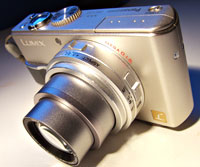 With a high-end feature set offering auto, scene, aperture and shutter priority modes plus full manual exposure controls, Panasonic’s beautifully sculpted 8 megapixel LX1 is clearly aimed at the discerning photographer who knows their ISO from their f-stop.
With a high-end feature set offering auto, scene, aperture and shutter priority modes plus full manual exposure controls, Panasonic’s beautifully sculpted 8 megapixel LX1 is clearly aimed at the discerning photographer who knows their ISO from their f-stop.
The camera – available in silver or black – is the world’s first compact camera to offer a panoramic 16:9 ratio CCD sensor -perfect for displaying on widescreen TVs – as well as 4:3 and 3:2 shooting ratios.
Despite its traditional appearance, the LX1 provides a class-leading level of control for digital photographers who like to wear the trousers when it comes to exposure (if you, err, get what we mean).
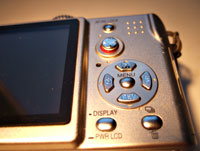 On most compact digcams, exposure adjustments are invariably achieved by fiddly excursions through endless sub-menus, but the LX1’s design affords fast, direct access to a host of vital functions like ISO rating, shutter speed, aperture and file size/quality – essential for those looking to capture the ‘decisive moment’.
On most compact digcams, exposure adjustments are invariably achieved by fiddly excursions through endless sub-menus, but the LX1’s design affords fast, direct access to a host of vital functions like ISO rating, shutter speed, aperture and file size/quality – essential for those looking to capture the ‘decisive moment’.
Aspect ratios
Most digicams use sensors with a 4:3 aspect ratio (similar to a standard TV), but the LX1 lets you choose between three different picture shapes; 16:9, 3:2 (print size) and 4:3.
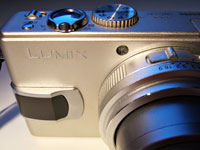 Although some cameras mimic a 16:9 shooting ratio by cropping off the top and bottom of the picture, the LX1 has a true 16:9 sensor, with users able to switch formats via a handy switch on the lens barrel (no sub-menu burrowing needed).
Although some cameras mimic a 16:9 shooting ratio by cropping off the top and bottom of the picture, the LX1 has a true 16:9 sensor, with users able to switch formats via a handy switch on the lens barrel (no sub-menu burrowing needed).
We grew to love the vast, cinema-like sweep of pictures recorded in 16:9 – so much so that photos taken on other digicams looked positively cramped in comparison.
Images came out pin-sharp courtesy of the Leica branded 28-112mm (equiv.), offering a bright F2.8 at the wideangle setting, dropping down to a less impressive F4.9 at the telephoto end.
It’s worth noting that you lose the extreme wideangle when you switch to the more conventional 4:3 or 3:2 modes, which offer a 34-136mm zoom range.
At the back of the camera, there’s a large, bright 207,000 pixel, 2.5-inch LCD screen with a near lag-free refresh rate. We had no problems seeing what was going on in all but the brightest of sunlight, but an optical viewfinder would have been a handy addition.
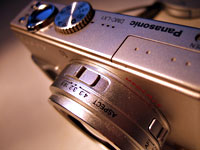 Camera controls
Camera controls
The main controls to the right of the LCD were simple and easy to use, and we had no problems navigating the menus using the four-way controller.
A smaller multi-directional ‘joystick’ lets you adjust aperture and shutter speeds in the relevant modes, as well as set manual focus.
Pressing the joystick brings up a convenient ‘quick menu’ for changing common shooting options like ISO, white balance etc – a great example of the photographer-led usability that sets this camera apart from the pack.
Panasonic did blot their copybook slightly however, with a few poor translations in their sub-menus – not what you expect from a top of the range camera.
 Photographic modes
Photographic modes
Along with the enthusiast-pleasing manual, aperture and shutter priority exposure modes, there’s a host of auto scene modes covering just about every photographic eventuality we can think of. These include portrait, sports, food, scenery, night scenery, self-portrait, night portrait and a rather curious ‘baby’ option.
In use, we found the LX1 to be very responsive, with impressively fast focusing, shutter lag and shot-to-shot times.
Exposure was spot on more or less every time, with the camera delivering stunning resolution, razor-sharp images stuffed full of detail.
The control layout proved intuitive and a pleasure to use, and we’d go as far as to say that this is the best handling compact digital camera we’ve ever come across – not only does the LX1 look great, it feels great to use too!
In fact, we found ourselves taking more pictures with the LX1 than any other camera on the desk, with its extensive range of features encouraging creativity and experimentation.
Flawed gem
The Lumix was on track to being our perfect camera, until we found a veritable swarm of bluebottles appearing in the ointment when the sun went down.
We’re talking high ISO image noise. Tons of it.
Even at 80 and 100 ISO there’s more noise than many of its rivals, and as the ISO ratings rose, the heartache increased.
At 200 ISO, you’ll be reaching for noise reduction software like Noise Ninja and Neat Image. At 400 ISO you’ll be wondering what possessed you to spend so much on the camera.
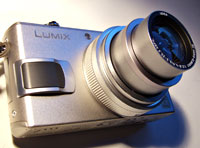 Of course, the capable image stabilisation goes some way to compensate for these serious shortcomings, allowing handheld longer exposures at low ISO ratings, but that’s going to be a dead loss if you’re trying to freeze action in low light.
Of course, the capable image stabilisation goes some way to compensate for these serious shortcomings, allowing handheld longer exposures at low ISO ratings, but that’s going to be a dead loss if you’re trying to freeze action in low light.
It’s a real shame that Panasonic has kitted this marvellous camera out with such a noisy sensor, although it needn’t be a deal breaker.
If you’re only looking to knock out small prints, then the high ISO noise won’t be so much of an issue, and if you’re prepared to put the work into processing RAW files, things improve radically.
Obviously, if your interest lies in landscapes, cityscapes, studio shots and other scenarios where low ISO ratings and tripods are de facto, image noise becomes a non issue.
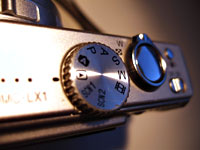 Conclusion
Conclusion
The Lumix LX1 is in many ways the perfect digital compact, offering a feast of features for demanding prosumers with enough automated modes to please the point’n’shoot brigade.
Offering unparalleled handling, lovely Leica-like looks (try saying that after a few beers), superb optics, fast handling and RAW capability, the camera is capable of producing astonishingly good results.
The only thing stopping us awarding the LX1 a frothing-at-the-mouth ten out of ten rating is its poor high ISO handling – but if you’re prepared to work within the camera’s limitations, you can expect to be rewarded with a camera capable of the very, very highest results.
RATING: 86%
Pros: Beautiful finish, fantastic handling, manual controls, pin-sharp lens, image stabilisation.
Cons: Unacceptable noise over 100ISO, clip on lens cover, average battery life.
Lumic LX1
Street price: UK: £350 (~$616 ~e509)
SPECS:
Sensor: 1/1.65″ CCD, 8.61 megapixels (16:9 aspect ratio)
Image Quality: RAW/TIFF/Fine/Standard
Movie clips: Quicktime (.mov) M-JPEG with audio – 640 x 480 (10/30 fps, 320 x 240 (10/30 fps), 848 x 480 (10/30 fps) (16:9)
Lens: Leica DC Vario-Elmarit, 28 – 112 mm equiv. (4x zoom), F2.8 – F4.9
MEGA OIS: (Mode 1 / Mode 2)
Shooting modes: Auto, Program Mode (with Program Shift), Aperture Priority Mode, Shutter Priority Mode, Manual Mode, Portrait, Sports, Food, Scenery, Night Scenery, Self-portrait, Night Portrait, Fireworks, Party, Snow, Baby, Soft Skin, Starry Sky, Candle, Moving Image
Shutter Speeds: 1/4 – 1/2000 sec.: Auto, 60 – 1/2000 sec. Manual
Sensitivity: Auto, ISO 80,100,200,400
Metering: Intelligent Multiple, Center-weighted, Spot
Continuous: 3 fps high speed, 2 fps low speed, 9 frames (standard), 5 frames (fine)
Flash: Auto, on/off, red-eye reduction: on/off, slow sync with red eye reduction
Range (ISO auto): W 0.6m – 4.1m, T: 0.3m – 2.3m
Storage: SD/MMC
Weight (inc batt) 220 g (7.8 oz)
Dimensions 106 x 56 x 26 mm (4.2 x 2.2 x 1.0 in)